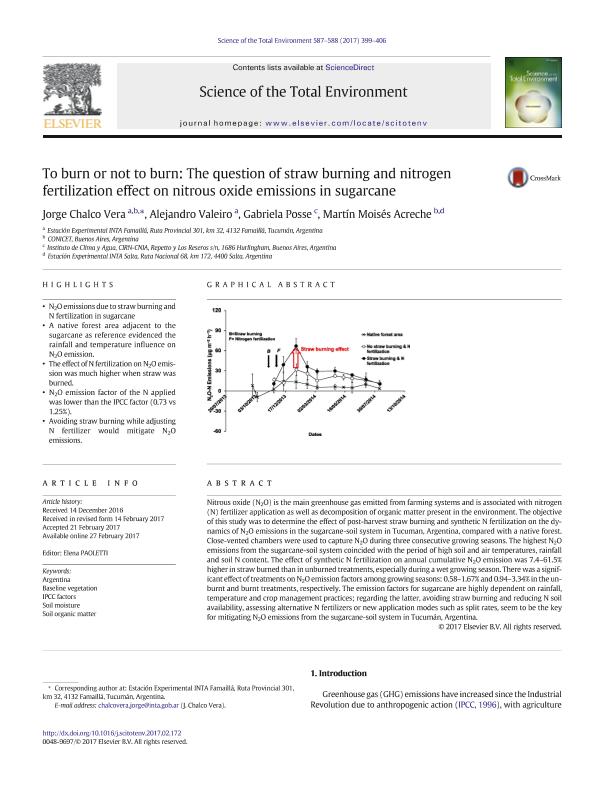Mostrar el registro sencillo del ítem
dc.contributor.author
Chalco Vera, Jorge Elías

dc.contributor.author
Valeiro, Alejandro
dc.contributor.author
Posse Beaulieu, Gabriela

dc.contributor.author
Acreche, Martin Moises

dc.date.available
2018-12-21T15:53:32Z
dc.date.issued
2017-06
dc.identifier.citation
Chalco Vera, Jorge Elías; Valeiro, Alejandro; Posse Beaulieu, Gabriela; Acreche, Martin Moises; To burn or not to burn: The question of straw burning and nitrogen fertilization effect on nitrous oxide emissions in sugarcane; Elsevier Science; Science of the Total Environment; 587-588; 6-2017; 399-406
dc.identifier.issn
0048-9697
dc.identifier.uri
http://hdl.handle.net/11336/66901
dc.description.abstract
Nitrous oxide (N2O) is the main greenhouse gas emitted from farming systems and is associated with nitrogen (N) fertilizer application as well as decomposition of organic matter present in the environment. The objective of this study was to determine the effect of post-harvest straw burning and synthetic N fertilization on the dynamics of N2O emissions in the sugarcane-soil system in Tucuman, Argentina, compared with a native forest. Close-vented chambers were used to capture N2O during three consecutive growing seasons. The highest N2O emissions from the sugarcane-soil system coincided with the period of high soil and air temperatures, rainfall and soil N content. The effect of synthetic N fertilization on annual cumulative N2O emission was 7.4–61.5% higher in straw burned than in unburned treatments, especially during a wet growing season. There was a significant effect of treatments on N2O emission factors among growing seasons: 0.58–1.67% and 0.94–3.34% in the unburnt and burnt treatments, respectively. The emission factors for sugarcane are highly dependent on rainfall, temperature and crop management practices; regarding the latter, avoiding straw burning and reducing N soil availability, assessing alternative N fertilizers or new application modes such as split rates, seem to be the key for mitigating N2O emissions from the sugarcane-soil system in Tucumán, Argentina.
dc.format
application/pdf
dc.language.iso
eng
dc.publisher
Elsevier Science

dc.rights
info:eu-repo/semantics/openAccess
dc.rights.uri
https://creativecommons.org/licenses/by-nc-sa/2.5/ar/
dc.subject
Argentina
dc.subject
Baseline Vegetation
dc.subject
Ipcc Factors
dc.subject
Soil Moisture
dc.subject
Soil Organic Matter
dc.subject.classification
Ingeniería Medioambiental y Geológica, Geotécnicas

dc.subject.classification
Ingeniería del Medio Ambiente

dc.subject.classification
INGENIERÍAS Y TECNOLOGÍAS

dc.title
To burn or not to burn: The question of straw burning and nitrogen fertilization effect on nitrous oxide emissions in sugarcane
dc.type
info:eu-repo/semantics/article
dc.type
info:ar-repo/semantics/artículo
dc.type
info:eu-repo/semantics/publishedVersion
dc.date.updated
2018-12-19T15:10:47Z
dc.journal.volume
587-588
dc.journal.pagination
399-406
dc.journal.pais
Países Bajos

dc.journal.ciudad
Amsterdam
dc.description.fil
Fil: Chalco Vera, Jorge Elías. Consejo Nacional de Investigaciones Científicas y Técnicas; Argentina. Instituto Nacional de Tecnología Agropecuaria. Centro Regional Tucuman-Santiago del Estero. Estación Experimental Agropecuaria Famaillá; Argentina
dc.description.fil
Fil: Valeiro, Alejandro. Instituto Nacional de Tecnología Agropecuaria. Centro Regional Tucuman-Santiago del Estero. Estación Experimental Agropecuaria Famaillá; Argentina
dc.description.fil
Fil: Posse Beaulieu, Gabriela. Instituto Nacional de Tecnología Agropecuaria. Centro de Investigación de Recursos Naturales. Instituto de Clima y Agua; Argentina
dc.description.fil
Fil: Acreche, Martin Moises. Consejo Nacional de Investigaciones Científicas y Técnicas; Argentina. Instituto Nacional de Tecnología Agropecuaria. Centro Regional Salta. Estación Experimental Agropecuaria Salta; Argentina
dc.journal.title
Science of the Total Environment

dc.relation.alternativeid
info:eu-repo/semantics/altIdentifier/doi/https://doi.org/10.1016/j.scitotenv.2017.02.172
dc.relation.alternativeid
info:eu-repo/semantics/altIdentifier/url/https://www.sciencedirect.com/science/article/pii/S0048969717304217
Archivos asociados
